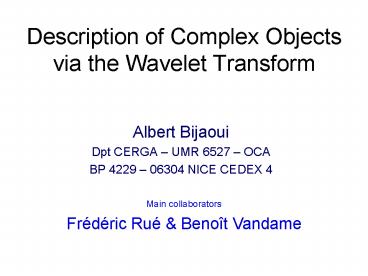Description of Complex Objects via the Wavelet Transform PowerPoint PPT Presentation
Title: Description of Complex Objects via the Wavelet Transform
1
Description of Complex Objectsvia the Wavelet
Transform
- Albert Bijaoui
- Dpt CERGA UMR 6527 OCA
- BP 4229 06304 NICE CEDEX 4
Main collaborators Frédéric Rué Benoît Vandame
2
A pixel value can be related to different objects
The galaxy L384-350 Superimposed
objects Hierarchical structures
3
Detectibility and Structures
At faint level the isophots are complex, so that
it is impossible to define the corresponding
fields
4
The vision depends on the smoothing
Smoothing at scale 1
Smoothing at scale 32
5
The Scale Space
- Set of smoothings
- Pyramids of Gaussian smoothings
- Equivalence of the isotropic diffusion PDE
- No linear smoothings
- Morphological operators
- Anisotropic diffusion equation
- Fundamental equation of the image processing
- To separate the information between different
scales the differences between smoothings
6
The wavelet transform
- Map a fonction f(x) into a fonction w(a,b)
- a scale - b position
- Four properties
- Linearity w(a,b)K(a)ltf(x),y((x-b)/a)gt
- Covariance with translations f0f(x-x0)
w0(a,b)w(a,b-x0) - Covariance with dilations fsf(sx)
ws(a,b)s-1 w(sa,sb) - Null mean lty(x)gt0
7
The Flow chart
Thresholding
Image
Wavelet Transform
Interscale relation
Segmentation
Object identification
Objects
Object Images
Image Reconstruction
8
The à trous algorithm flow-chart
9
Thresholding and Labelling
10
Interscale relation and objects
An object is a local maximum of the WT
11
Reconstruction
12
Example on the IR image of the planetary nebula
NGC40
The linear structures are fragmented
13
Itérations
14
Cluster of galaxies A521(ROSAT)
15
MVM on Abel 5121
16
Structure separation
17
Conclusion
- MVM may be applied to surveys
- Complexity
- CPU
- Two classes of objects
- Stellar / Quasi stellar objects
- Complex structures
- MVM is well adapted to describe complex
structures - Problem with linear, ringed, wavy structures
PowerShow.com is a leading presentation sharing website. It has millions of presentations already uploaded and available with 1,000s more being uploaded by its users every day. Whatever your area of interest, here you’ll be able to find and view presentations you’ll love and possibly download. And, best of all, it is completely free and easy to use.
You might even have a presentation you’d like to share with others. If so, just upload it to PowerShow.com. We’ll convert it to an HTML5 slideshow that includes all the media types you’ve already added: audio, video, music, pictures, animations and transition effects. Then you can share it with your target audience as well as PowerShow.com’s millions of monthly visitors. And, again, it’s all free.
About the Developers
PowerShow.com is brought to you by CrystalGraphics, the award-winning developer and market-leading publisher of rich-media enhancement products for presentations. Our product offerings include millions of PowerPoint templates, diagrams, animated 3D characters and more.

